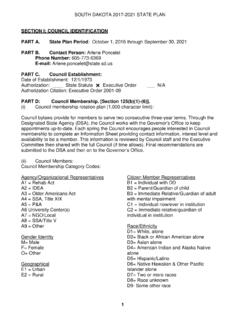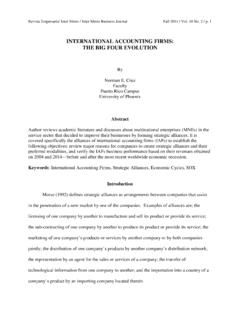Transcription of LSI-R: Level of Service Inventory-Revised
1 LSI-R: Level of Service Inventory-Revised Introductory training course: 1 Level of Services Inventory-Revised Participant Manual Much of the material contained within this manual has been adapted from the work of William R. Miller, and Stephen Rollnick, Motivational Interviewing (1999, 2002); Dr. Don Andrews and Dr. James Bonta, Psychology of Criminal Conduct, Second Edition; Kathy Gibbs, Sally Kraemer and Kim McIrwin, Iowa Department of Corrections, LSI-R training manual 2000, Jason Anderson, Minnesota Dept of Corrections, LSI-R training manual 2012. 2 3 Introductory LSI-R Training Objectives By the end of the training the participants will be able to: 1. Understand the basic principles and theories underlying the LSI-R. 2.
2 Identify three principles of effective interventions for correctional practice. 3. Identify the 4 biggest risk factors for future criminal activity. 4. Have basic understanding of LSI-R scores and how to respond to those scores. 4 Introductory LSI-R Training Agenda INTRODUCTIONS: Introduction of the trainers and participants Agenda Housekeeping CAR BUYING ACTIVITY SOCIAL LEARNING THEORY Cost vs. Rewards Additive vs. Subtractive Density Cost and Rewards Activity IMPORTANCE OF ASSESSEMENTS WHAT IS THE LSI-R Uses of LSI-R Sources of information What does it mean/how can it be used? FUNDEMENTALS OF EFFECTIVE INTERVENTION Big 4 and Central 8 risk factors R-N-R principle QUESTION/ANSWER EVALUATION: WRAP UP 5 Effective Correctional Intervention Principles and Predictors Promising Targets for Change Predictors of Criminal Conduct The big four Social Learning Theory 6 Principles of Effective Correctional Intervention Risk Need Responsivity Cognitive Behavioral Special Consideration Professional Override The Risk Principle Offender risk should be matched to Level of Service .
3 Higher levels of Service should be reserved for high risk cases. Treatment Effectiveness Minimal Treatment (Regular Supervision) Augmented Treatment High Risk Probationers 75% Recidivated 33% Recidivated Low Risk Probationers 7% Recidivated 14% Recidivated 7 The Need Principle When dynamic risk factors (criminogenic needs) are changed, there is a subsequent decrease in the likelihood of further criminal behavior. The Responsivity Principle Match officer style and mode of intervention to special offender characteristics More on the Responsivity Principle: Client Factors: Motivation (as a barrier) Engages in Denial and/or Minimization Interpersonally Anxious Cultural / Ethnicity Issues Communication Barriers Low Intelligence Leaning Disabled or Brain Injured 8 Predictors of Criminal Conduct Lower Class Origins Socioeconomic Characteristics of Neighborhood Signs of Parental Education / Occupation / Income Family of Origin Long Term Reliance on Welfare Emotional Criminality in Close Relatives Multiple Psychological Handicaps Antisocial Attitudes Low levels of affection / cohesiveness in home Low levels of supervision / poor discipline in home Neglect / abuse Personal Temperament and Early Behavioral History Restlessly energetic Impulsive Adventurous pleasure-seeking Taste for risk Below average verbal intelligence
4 Response to frustration more likely to involve anger and resentment Lack of conscientiousness Egocentrism Callousness Moral immaturity Poor problem solving / coping skills Childhood diagnosis of conduct disorder Early and generalized misconduct 9 School-Based Risk Factors Below average effort Lack of interest / being bored Not worrying about occupational future Conduct problems Poor schools (low caring, low structure) Educational / Vocational / Socioeconomic Achievement Low Level of achieved education Long periods of unemployment Reliance on welfare Interpersonal Relationships Generalized indifference to the opinions of others Unstable marital history Rejected / rejecting Social Support for Crime Association with antisocial / drug using others Isolation from non-criminal others Personal Attitudes/Values/Beliefs Supportive of Crime High tolerance for deviance in general Rejection of the validity of the law Rationalizes law violations of a wide variety Interprets a wide range of stimuli as reasons for anger, resentment and/or defiance Generally.
5 Thinking style and content is antisocial Behavioral History Criminal history Juvenile and Adult Alcohol and drug abuse Aimless use of leisure time Disorganized lifestyle Personal Distress / Psychopathology High scores on measures of antisocial personality / psychopathy Active Psychosis with delusions Psychological signs of anxiety, worry, depression, low self-esteem and sociological signs of anomie, alienation, normlessness, powerlessness and isolation. Other Risk Factors Being male Being young Being a member of some minority groups Andrews and Bonta (1994): UNB/CU (Gendreau, Coggin, Chanteloupe) 1. Lower Class Origins .06 (97) 2. Personal Distress / Psychopathology.
6 08 (226) 3. Personal Educational achievement .12 (129) 4. Personal / Family Factors .18 (334) 5. Temperament/Misconduct/personality .21 (621) 6. Antisocial Attitudes/Associates .22 (168) 10 11 Mean Correlation between Different Types of Potential Correlates of Criminal Conduct by Gender Risk Factor Male Female Lower Class Origins .04 (58) .03 (12) Personal Distress / Psychopathology .09 (157) .08 (19) Personal Education / Vocational Achievement .11 (96) .13 (7) Parental / Family Factors.
7 16 (180) .16 (43) Temperamental / Misconduct / Personality .18 (461) .23 (38) Antisocial Attitudes / Associates .21 (113) .23 (12) Overall .16 (1065) .16 (131) 12 UNB: Adult Offender Record T. Little and P. Gendreau (1995) 1. Lower Class Origins .06 (24) 2. Personal Distress .05 (64) 3. Lower Intelligence .07 (31) 4. Family of Origin .11 (76) 5. Parenting Factors .15 (27) 6. Personal Educational Achievement .15 (154) 7. Criminogenic Need .16 (175) 8. History of Antisocial Behavior .16 (245) 9.
8 Antisocial Personality .18 (62) 10. Antisocial Companions .18 (27) 11. Antisocial Attitudes .19 (29) 12. Composite Risk Scales .30 (123) 13. Age / Race / Gender .14 (94) The big four History of Antisocial Behavior Antisocial Attitudes Antisocial Associates Antisocial Personality Pattern 13 14 14 Promising Targets for Change 1. Changing antisocial attitudes. 2. Changing/managing antisocial feelings. 3. Reducing antisocial peer associations. 4. Promoting familial affection/communication. 5. Promoting familial monitoring and supervision.
9 6. Promoting child protection (preventing abuse). 7. Promoting identification/association with anti-criminal role models. 8. Increasing self-control, self-management, and problem solving skills. 9. Replacing the skills of lying, stealing and aggression with pro-social alternatives. 10. Reducing chemical dependencies and substance abuse 11. Shifting the density of personal, interpersonal and other rewards and costs for criminal and non-criminal activities in familial, academic, vocational, recreational, and other behavioral settings so that the non-criminal alternatives are favored. 12. Providing the chronically mentally ill with low pressure, sheltered living arrangements and/or effective medication. 13. Insuring the Client is able to recognize risky situations and has a concrete, well-rehearsed plan for dealing with them.
10 14. Confronting the personal and circumstantial barriers to Service ( , motivation). 15 7 Less Promising Targets for Change 1. Increasing self-esteem (without simultaneously reducing antisocial thinking, feelings, and peer association). 2. Focusing on vague Emotional/Personal complaints that are not linked with criminal conduct. 3. Increasing cohesiveness of antisocial peer groups. 4. Improving neighborhood-wide living conditions without touching the criminogenic needs of higher risk individuals and families. 5. Showing respect for antisocial thinking on the grounds that the values of one culture are as equally valid as the values of another culture (when a culture holds criminal values that harm others.) 6. Increasing conventional ambition in areas of school and work without concrete assistance in realizing these ambitions.













